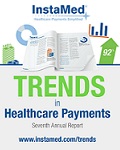 By Chris Seib, Chief Technology Officer & Co-Founder, InstaMed
By Chris Seib, Chief Technology Officer & Co-Founder, InstaMed
Twitter: @InstaMed
Twitter: @CDSeib
In December 2016, several industry experts contributed to an article for HITECH Answers with their health IT predictions for the upcoming year. Bill Marvin, CEO and Co-Founder of InstaMed, discussed the trend of consumerism due to rising payment responsibility and the need for action in 2017 to address the new role of consumers as key stakeholders in the industry. In Bill’s words: “consumer-centric organizations are going to have a great 2017!”
The Seventh Annual Trends in Healthcare Payments Report was released in May 2017 and supports Bill’s analysis of the growing role of consumers in the industry. Here are the highlights from the report that proves his prediction is holding true for 2017 and will continue to do so for years to come.
Consumer Healthcare Financial Realities
For healthcare services, payment responsibility has increased in part due to high deductible health plans, which have become increasingly more popular with employer groups and in the individual market. In 2010, 10 million consumers were enrolled in high deductible health plans (AHIP) – less than a decade later, 75 million consumers are now enrolled in HDHPs, a more than seven-fold increase (CDC’s National Center for Health Statistics).
What Does This Mean For Providers?
As seen in recent years, the trend in increasing consumer responsibility requires that providers must collect a larger portion of their revenue directly from patients. This holds true for 2016 as 72 percent of providers reported an increase in patient responsibility over 2015 (Provider Healthcare Payments Survey 2016). Since 2013, the majority of providers have consistently reported this increase in patient responsibility.
The burden to collect from patients has become a growing concern for providers as the top three provider revenue cycle concerns in 2016 were related to patient payments: increases in patient responsibility for payment, how to increase cash flow and ways to reduce days in accounts receivable. In particular, the last concern is validated by the 73 percent of providers who reported that it takes one month or longer to collect from a patient.
Healthcare Is Wrought With Confusion
Despite these shifts driven by consumer payments, many in the industry have been slow to acknowledge or encourage the consumer’s new role as an industry stakeholder. Consider that 92 percent of consumers reported that it was important to know their payment responsibility prior to a provider visit (Consumer Healthcare Payments Survey 2016). Yet, only a third of consumers understood their payment responsibility when a deductible or copay were part of their health plan (University of Connecticut’s Health Disparities Institute).
Typically, consumers are only aware that they may have payment responsibility after they seek healthcare services when they are sent an explanation of benefits (EOB) by their health plan. Though it discusses payment responsibility, the EOB typically includes bold language that it is not a bill and should not be paid by the consumer. This mixed messaging may be one of the reasons that 74 percent of consumers are confused by EOBs (Consumer Healthcare Payments Survey 2016).
Consumer confusion does not lessen when the provider sends a statement for payment responsibility as 74 percent of consumers were also confused by their medical bills (Consumer Healthcare Payments Survey 2016).
There are various contributing factors to this confusion. One disconnect is that consumers may not receive statements for services until weeks or even months have passed. Another cause can be lack of billing consolidation between different organizations under a single business identity, which means that a consumer could reasonably receive multiple statements for what they consider to be one visit.
The Impacts of Consumer Demands to Revenue and Brand
The ability to ignore or deprioritize consumer demands in healthcare payments may no longer be an option. The consequences of inaction go beyond just longer days in accounts receivable or bad debt. The trends now delineate a clear correlation between the payment experience and a healthcare organization’s brand. For example, patients who are satisfied with billing are five times more likely to recommend the hospital (2015 HCAHPS Survey). How a consumer views a healthcare organization has direct ties to that organization’s revenue. Between 2008 and 2014, hospitals with excellent HCAHPS patient ratings had a net margin of 4.7 percent compared to just 1.8 percent for hospitals with low ratings (Deloitte).
The Trends in Healthcare Payments Seventh Annual Report: 2016 is now available to download – free of charge. For the last seven years, InstaMed has released this report to objectively educate the market and promote awareness, change and greater efficiency through quantitative data from the InstaMed Network and qualitative data from healthcare providers, payers and consumers surveyed nationwide.

